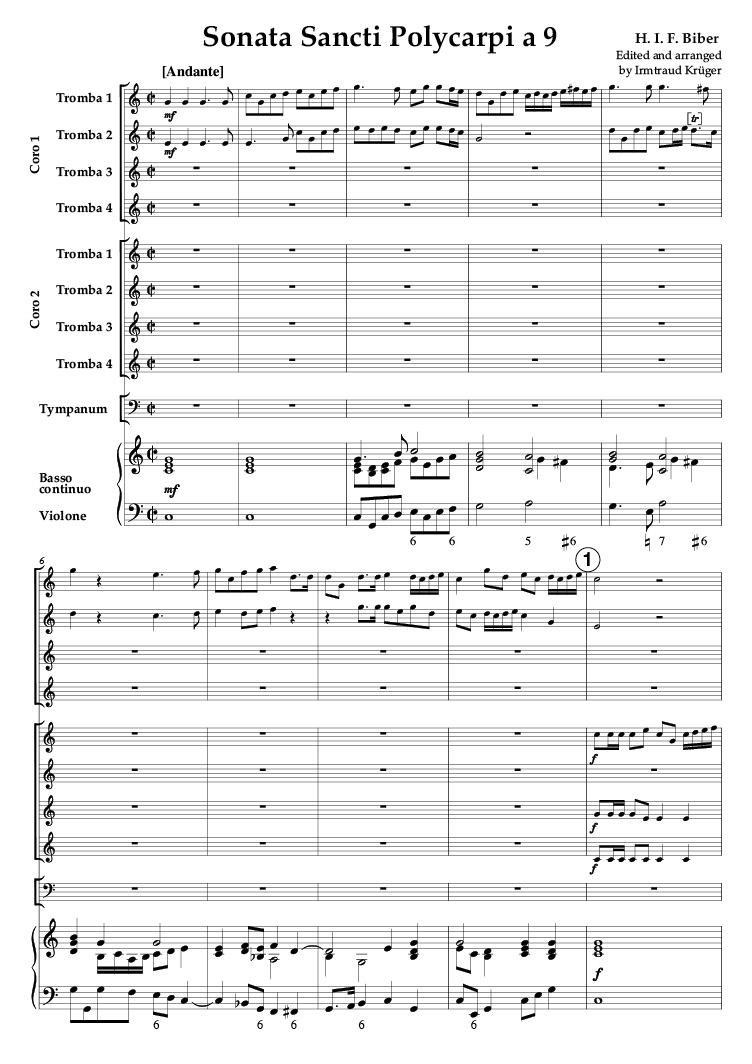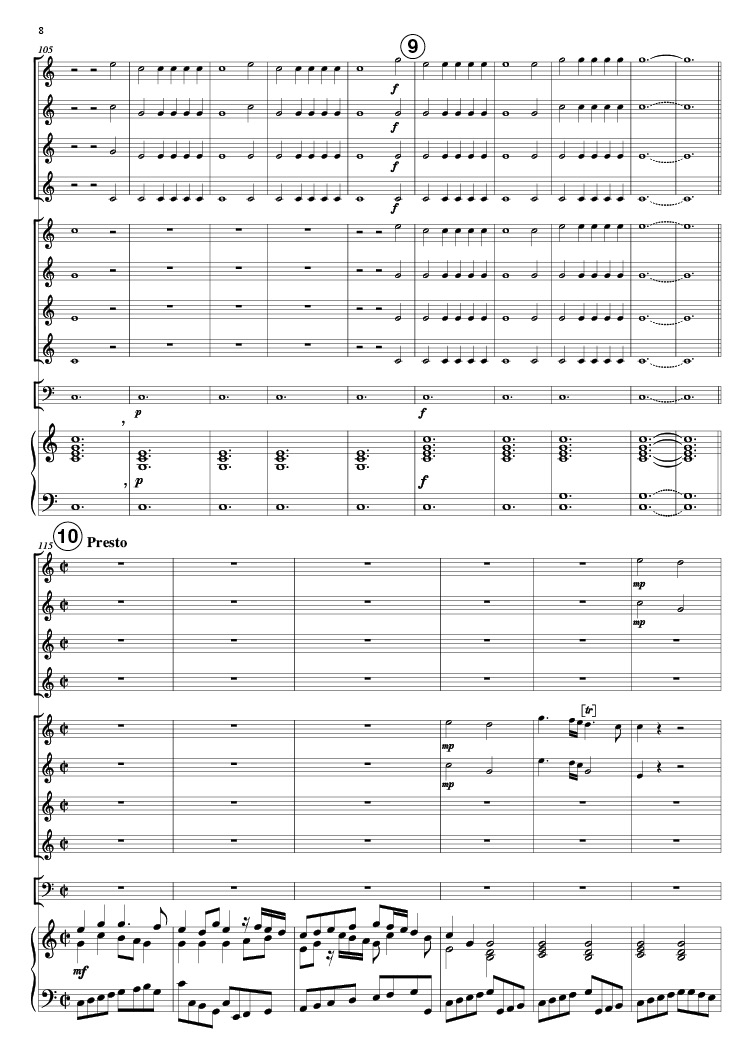
Biber Sonata sancti Polycarpi
Difficulty (I-VI): VParts for: Trumpets 1-8, Tympani, Violone, B.c. (2nd score)
Editor: Irmtraud Krüger
Series: Edward Tarr Brass
The Composer
Heinrich Ignaz Franz Biber was born in 1644 in Wartenberg, Bohemia. From 1666 to 1670 he was a musician and composer – not Kapellmeister, as is often stated – at the residence of the Prince-Bishop of Olmütz (Olomouc), Carl Liechtenstein-Castelcorn (1624-95), in Kremsier (Kromíž). During Liechtenstein-Castelcorn’s reign (from 1664), following the Thirty Years’ War, his court experienced the most brilliant period of its history. Not only did the prince-bishop do a lot of building, including the imposing castle which was his place of residence, with its formal gardens, but he also created ecclesiastical foundations and gathered together a large court orchestra. The court also had an excellent trumpet corps under Chief Court Trumpeter Pavel Josef Vejvanovský (1639/40-1693). According to Jii Sehnal, their art was so renowned near and far that the prince-bishop was often requested to make them available for diverse festivities of the nobility or of the military authorities. Vejvanovský is remarkable in the history of his instrument in that he was also a composer of distinction. After Biber’s departure he even succeeded him as court composer.
Biber left Kremsier in 1670 for Salzburg, receiving an appointment as a member of the court orchestra in the winter of 1670-71. Although he apparently had taken “French leave” from Kremsier, greatly annoying his former employer, he apparently reassumed cordial relations with him within a short period of time. From his new place of residence, Biber continued regularly to send copies of his compositions to Kremsier, and many of them survive today only there, including the present work. (Liechtenstein-Castelcorn’s important music collection includes not only the only surviving music of Tolar and Vejvanovský, but also most of that written by several composers at the Viennese court of Leopold I, including Bertali, Biber, Poglietti, and Schmelzer.) In 1677 Biber was promoted, receiving responsibility for the training of the cathedral choirboys in the singing of florid counterpoint; in 1679 he became vice music director, and in 1684 he was named dean of the choirboys’ school and court music director, succeeding the former court and cathedral Kapellmeister Andreas Hofer (1629-84). He was knighted in 1690 and thus entitled to sign his name “von Bibern”. He died in 1704 in Salzburg.
His Works
Biber has enjoyed a small renaissance in recent years. Previously he was known mainly for his violin sonatas, which are of the highest quality and represent the summit of the contemporary violinist's art. Now his large-scale works for voices and instruments, including the 53-part Missa Salisburgensis formerly attributed to Benevoli, have captured public attention and can be heard on several CD recordings.
Biber as a Composer for the Trumpet – the “Sonata Sancti Polycarpi”
In addition to the works mentioned, Biber was an important composer for the trumpet. A significant collection is Sonatae tam aris quam aulis servientes (Salzburg 1676) for strings and basso continuo, of which two feature a solo trumpet (Nos. 4, 10) - one of these (No. 10) being in the rare key of G minor - and two are for two trumpets (Nos. 1, 7).
The fact that this collection, with its prominent trumpet parts, was published in Salzburg shows that the archbishop's court there also had a first-rate group of trumpeters in its employ. The quality of the Salzburg trumpet corps remained high for another generation as well. Prominent trumpet parts appear in the works of Biber's son Carl (1681-1749), and Leopold Mozart, writing in 1757, named three Salzburg trumpeters – Resenberger, Köstler, and Schachtner, the latter a friend of the Mozart family – who enjoyed special distinction for their delicate, tasteful playing in the high register.
The title of the present sonata refers to Polycarp (70-156 A. D.), an early church father and martyred Bishop of Smyrna not associated with music. Why choose this saint, then, for a monumental work with trumpets? The celebratory character of the piece itself, as well as the nature of 17th-century patronage, furnish decisive clues. The Archbishop of Salzburg's nephew was named Polykarp von Khüenburg. There are three occasions on which Biber's Sonata Sancti Polycarpi could have been performed: on Khüenburg's installation as provost of Salzburg Cathedral (13 January 1673), on his name day (23 February), or on his installation ceremony as Bishop of Gurk (2 April 1673).
Similar works for 5 and 6 trumpets, respectively, with timpani and continuo, survive in Kremsier: the anonymous Sonata à 5 Clarini (1670), published by mcnaughtan, and Biber's Sonata à 7 (1668). He outdid himself in the present work, making the necessity of the natural trumpet's limited modulatory possibilities into the virtue of the manifold echo and answering effects possible of two choirs of trumpets and a sparingly used but telling timpani part.
The Original Source
Source: Kremsier, Archbishop’s Palace, Music Archive, autograph parts; old call number B IV 187 (later no. 123), new call no. A 611. The title page of the original set of parts bears the following heading: Sonata S. Polycarpi / … À 9 / 8 Trombe / Tympan[i] / von / Heinrich I F Biber. The names of the surviving parts are: Tromba 1 to 8, Tympanum, Violone, and Basso Continuo (the latter with figures). Biber's trumpets 1, 2, 5, and 6 have been assigned in this edition to Choir I and re-numbered 1-4; similarly, his trumpets 3, 4, 7, and 8 have been renumbered 5-8 and play in Choir II.
It is provocative to think that trumpets and organs were usually in choir pitch and that modern performances calling themselves “authentic” might best be in C at a’ = c. 465 Hz, or in D at a’ = c. 415 Hz. Editorial emendations are marked as such, except for breath marks and dynamic indications, which were lacking from the original source. Small notes in the optional timpani part (bar 156) represent a suggested editorial embellishment. The right hand of the continuo part was composed by the editor.
Biber’s Note on Performance and Its Consequences
At the bottom of the title page, Biber wrote an important note concerning the spatial disposition of the trumpeters:
“NB das Tromba 1. et 2. auch 5. undt 6. alle Vier müssen beysammen stehen. Undt Tromba 3. 4. 7. 8. auch beysammen, dan Sie gehen in Tripla ad duos choros. Der Violon aber undt der Bass Continus so vil es sein kan müssen starck besetzt werden, die Quartuba kan wol gebraucht werden.”
It can be translated as follows:
NB. Trumpets 1 and 2, as well as 5 and 6 - all four must stand together. Trumpets 3, 4, 7, 8 also together, because in the triple time they split up into two choirs. But the violone and the basso continuo, as many as there can be, must be performed by as many players as possible; the quartuba may well be used.
There have been several editions of this work – by Edward Tarr (Brass Press, long out of print), Robert Minter (Musica Rara), and Sehnal (DTÖ) –, and I would like to take advantage of two decades of my own performing experience in ensembles of historic instruments to add my contribution with the present edition, which hopefully combines the advantages of its predecessors without including their weaknesses. The continuo realization, for instance, is in a low register so as to add fulness to the ensemble sound; it has been kept simple to aid embellishment by talented performers. In particular, I have followed Tarr's sensible redisposition of the trumpet parts so that there are two high and two low players in each choir (see below), at the same time retaining Biber's original disposition in small notes (cue size) if six high and two low players are preferred. In any case, the two trumpet choirs should stand at a certain distance from each other for maximum effect.
According to Biber's original note, the continuo part should be given to as many players as possible. Thus a combination of keyboard instruments – organ, theorbo, harpsichord in alternation or together – could be used to advantage. With a little imagination and a minimum of language skill, the quartuba to which he refers can be understood to mean a bass trombone. Latin terms were popular at the time: the Latin word for trumpet is tuba, the trombone is a large trumpet, and the German word for bass trombone is Quartposaune. It makes a very good effect if this instrument is used to reinforce the bass line.



